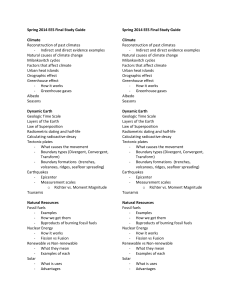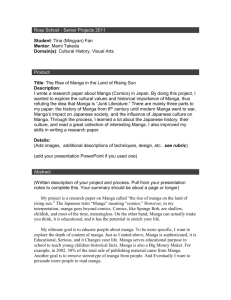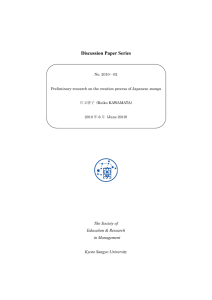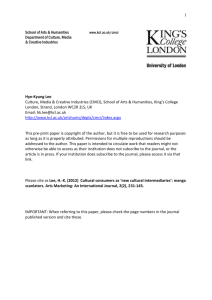[Hydrogeological effects in central new zealand from large (M>5.8
advertisement
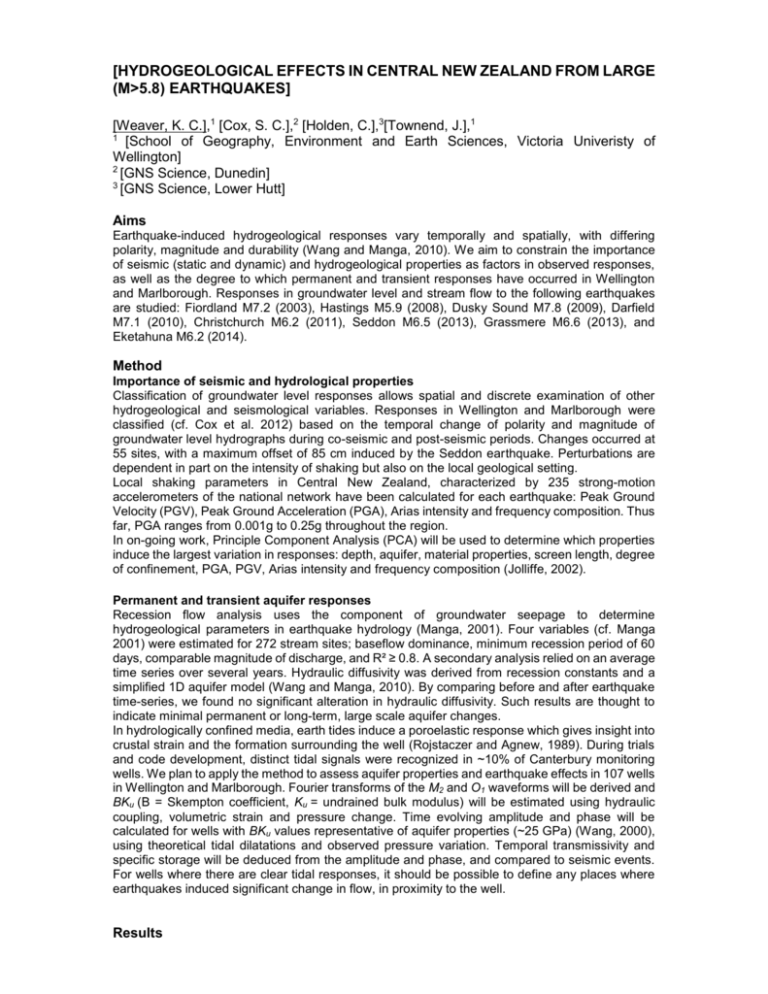
[HYDROGEOLOGICAL EFFECTS IN CENTRAL NEW ZEALAND FROM LARGE (M>5.8) EARTHQUAKES] [Weaver, K. C.],1 [Cox, S. C.],2 [Holden, C.],3[Townend, J.],1 1 [School of Geography, Environment and Earth Sciences, Victoria Univeristy of Wellington] 2 [GNS Science, Dunedin] 3 [GNS Science, Lower Hutt] Aims Earthquake-induced hydrogeological responses vary temporally and spatially, with differing polarity, magnitude and durability (Wang and Manga, 2010). We aim to constrain the importance of seismic (static and dynamic) and hydrogeological properties as factors in observed responses, as well as the degree to which permanent and transient responses have occurred in Wellington and Marlborough. Responses in groundwater level and stream flow to the following earthquakes are studied: Fiordland M7.2 (2003), Hastings M5.9 (2008), Dusky Sound M7.8 (2009), Darfield M7.1 (2010), Christchurch M6.2 (2011), Seddon M6.5 (2013), Grassmere M6.6 (2013), and Eketahuna M6.2 (2014). Method Importance of seismic and hydrological properties Classification of groundwater level responses allows spatial and discrete examination of other hydrogeological and seismological variables. Responses in Wellington and Marlborough were classified (cf. Cox et al. 2012) based on the temporal change of polarity and magnitude of groundwater level hydrographs during co-seismic and post-seismic periods. Changes occurred at 55 sites, with a maximum offset of 85 cm induced by the Seddon earthquake. Perturbations are dependent in part on the intensity of shaking but also on the local geological setting. Local shaking parameters in Central New Zealand, characterized by 235 strong-motion accelerometers of the national network have been calculated for each earthquake: Peak Ground Velocity (PGV), Peak Ground Acceleration (PGA), Arias intensity and frequency composition. Thus far, PGA ranges from 0.001g to 0.25g throughout the region. In on-going work, Principle Component Analysis (PCA) will be used to determine which properties induce the largest variation in responses: depth, aquifer, material properties, screen length, degree of confinement, PGA, PGV, Arias intensity and frequency composition (Jolliffe, 2002). Permanent and transient aquifer responses Recession flow analysis uses the component of groundwater seepage to determine hydrogeological parameters in earthquake hydrology (Manga, 2001). Four variables (cf. Manga 2001) were estimated for 272 stream sites; baseflow dominance, minimum recession period of 60 days, comparable magnitude of discharge, and R² ≥ 0.8. A secondary analysis relied on an average time series over several years. Hydraulic diffusivity was derived from recession constants and a simplified 1D aquifer model (Wang and Manga, 2010). By comparing before and after earthquake time-series, we found no significant alteration in hydraulic diffusivity. Such results are thought to indicate minimal permanent or long-term, large scale aquifer changes. In hydrologically confined media, earth tides induce a poroelastic response which gives insight into crustal strain and the formation surrounding the well (Rojstaczer and Agnew, 1989). During trials and code development, distinct tidal signals were recognized in ~10% of Canterbury monitoring wells. We plan to apply the method to assess aquifer properties and earthquake effects in 107 wells in Wellington and Marlborough. Fourier transforms of the M2 and O1 waveforms will be derived and BKu (B = Skempton coefficient, Ku = undrained bulk modulus) will be estimated using hydraulic coupling, volumetric strain and pressure change. Time evolving amplitude and phase will be calculated for wells with BKu values representative of aquifer properties (~25 GPa) (Wang, 2000), using theoretical tidal dilatations and observed pressure variation. Temporal transmissivity and specific storage will be deduced from the amplitude and phase, and compared to seismic events. For wells where there are clear tidal responses, it should be possible to define any places where earthquakes induced significant change in flow, in proximity to the well. Results The assessment utilises 15 years of hydrological data and eight recent large (M>5.8) seismic events at near to far-field distances (30-800 km), with Modified Mercalli shaking intensities of I-VII (unnoticeable-severe) (Figure 1). It appears that observed groundwater level changes (<1 m), that were both transient (<1 hour) and persistent (weeks-months), mostly reflect stress and strain induced pressure changes imposed by these earthquakes, rather than large-scale aquifer-damage or changes to hydrogeology. Future PCA analysis will help to constrain the main factors that affect groundwater pressure fluctuations and aquifer damage. Figure 1 – (Left) Distribution of recent large magnitude earthquakes in New Zealand. (Right) Distribution of seismological and hydrological monitoring sites in Central New Zealand. NIWA = The National Institute of Water and Atmospheric Research. GWRC = Greater Wellington Regional Council. MDC = Marlborough District Council. References Cox, S. C., Rutter, H. K., Sims, A., Manga, M., Weir, J. J., Ezzy, T., White, P. A., Horton, T. W., and Scott, D. (2012). Hydrological effects of the Mw 7.1 Darfield (Canterbury) earthquake, 4 September 2010, New Zealand. NZJGG. 55 (3) 213-247. Jolliffe. (2002) Principal component analysis and factor analysis. Principle component analysis. 150-166. Manga. (2001). Origin of postseismic streamflow changes inferred from baseflow recession and magnitudedistance relations. GRL. 28 (10), 2133-2136. Rojstaczer and Agnew. (1989). The influence of formation material properties on the response of water levels in wells to Earth tides and atmospheric loading. JGR, 94 (B9), 12403-12411. Wang. (2000). Theory of linear poroelasticity with applications to geomechanics and hydrogeology. Princeton University Press. Wang and Manga. (2010). Earthquakes and Water. New York, Springer. Acknowledgements: We wish to thank Greater Wellington Regional Council (Sheree Tidswell and Doug Mzila), Marlborough District Council (Peter Davidson and Mike Ede), The National Institute of Water and Atmospheric Research (Kathy Walters) and GeoNet for the collection and provision of outstanding monitoring datasets used in this study.








